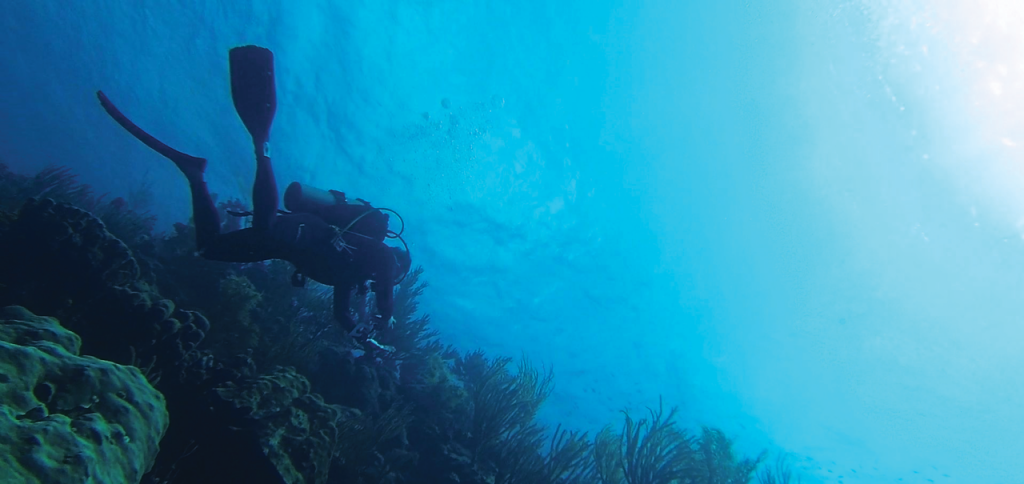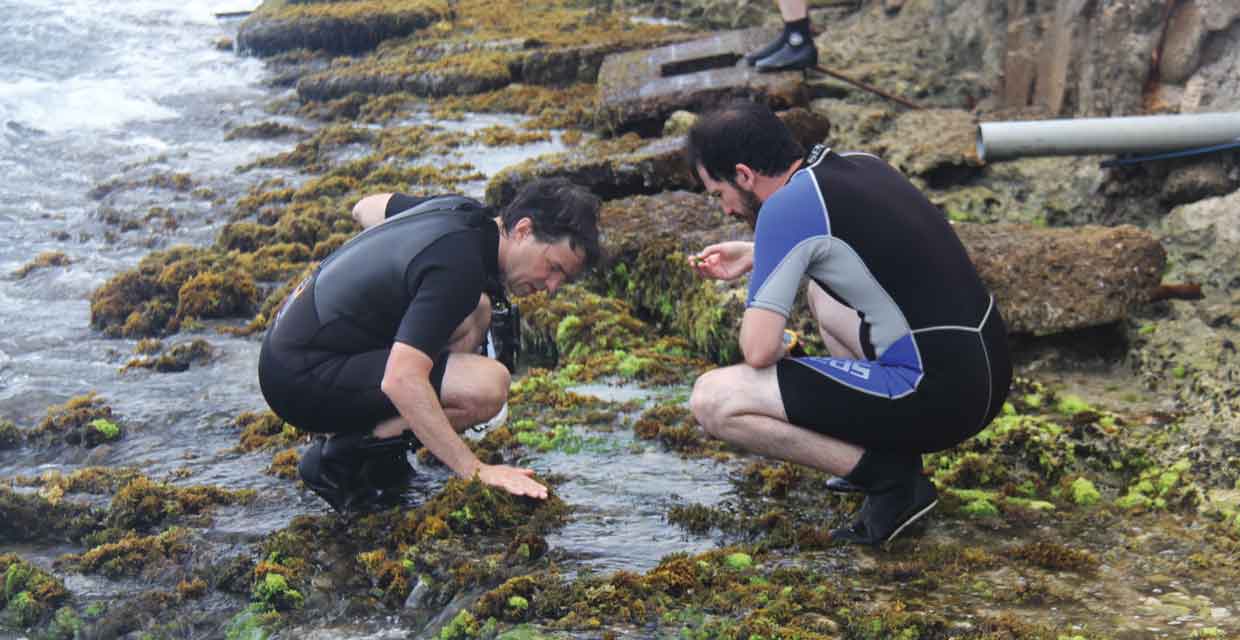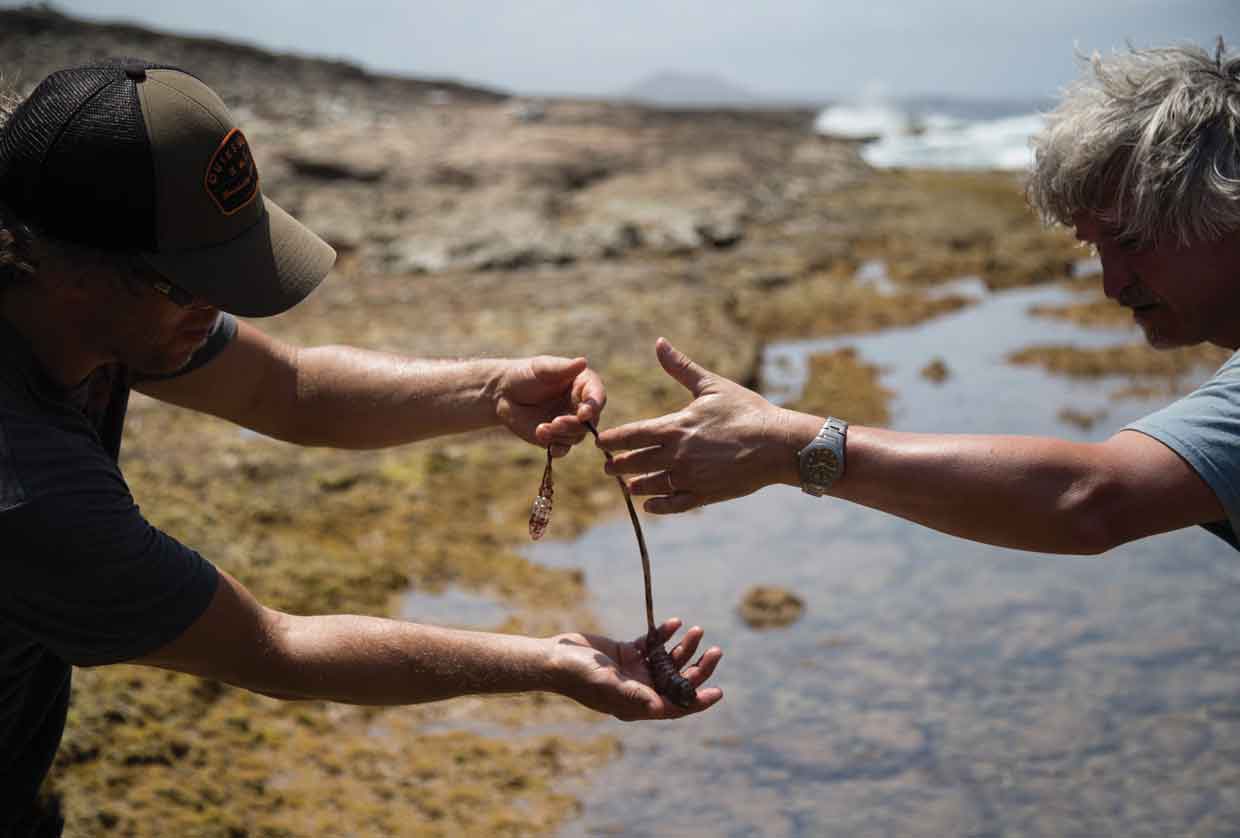By: Anne Casselman
17 Jun, 2016

As they chatted with the director of the local research station, Mark Vermeij, they had a brainstorm: they were in a position to quickly collect samples of every single species of Caribbean coral, along with the associated microbial communities that help to sustain them. By dinner the next day, they had 50 samples.
“That’s the kind of thing you can do on the fly with a group like that, that you could never do by yourself,” says Keeling, director of the IMB program and a microbiologist at the University of British Columbia.
The fellows had organized the trip specifically to study protists, a group of microorganisms that are profoundly important for the health of coral reefs and of oceans in general. Protists even play a major role in the Earth’s carbon cycle, which has serious implications for climate change.
“The last 10 years has been the age of discovery in microbiology, and in my opinion the protists are the last frontier of that,” says Rohwer, a senior fellow in the IMB program and a marine microbial ecologist at San Diego State University. “We’re right at that edge where we don’t really know what’s going on, and so we’re finding things out.”
Protists are major contributors to ocean productivity and marine food webs. But much about their ecological role in the ocean remains unknown, and their contribution to carbon and nutrient cycles remains unquantified. Understanding protists better will allow us to create more accurate models of global climate change, which has serious implications for the future health of our planet.
Well aware of the knowledge gaps – and of the urgency to narrow them as global change stresses marine systems – many of CIFAR’s IMB fellows are studying marine protists. Theyare using a combination of field research and dogged lab work, aided by innovative biomolecular tools and techniques which, often, they’re developing and beta-testing as they go.

Parasitologist Jan Votypka. Photo: Gordon Lax
Protists are defined more by what they aren’t than by what they are. They are eukaryotes (that is, organisms whose cells contain a nucleus) which are not animals, fungi or plants. Some familiar protists are amoebae, algae, slime moulds and dinoflagellates. Others verge on the outlandish. Some species have evolved a poisonous harpoon to capture prey. Another contains a unicellular eyeball, complete with a lens and retina. Some are photosynthetic, others are predatory; many even switch back and forth.
In other words, despite being single-celled (mostly) and tiny, protists often inhabit ecological niches that we’re used to seeing in terrestrial ecosystems. There are hunters, photosynthesizers and grazers. And there are protists that defy categorization: hunters who can also be grazers and hunters who are also like plants.
Researchers know that protists play critical roles in marine ecosystems. For instance, phytoplankton form the base of marine food webs and are responsible for transporting atmospheric CO2 into the deep ocean. Other protists play huge roles in the ecology of microbial sea life through predation and parasitism.
But protists have remained relatively under-studied and largely uncatalogued, largely because they’re the hardest micro-organisms to isolate and investigate. Despite their outsized role in marine microecology, they are not numerically abundant. Also, they are hard to culture in the lab, and extremely complex at the levels of structure and behaviour; bulk DNA sequencing of seawater doesn’t tell biologists much about their life strategies.
Also, unlike zoologists studying lions, micro-biologists cannot yet tag a single cell in the ocean, track its whereabouts and study its behaviour – although this is something IMBinvestigators are working on. More sensitive and innovative methods are required to understand how protists interact with and influence the marine environment.
Biologists focus their efforts on certain model ecosystems to infer and extrapolate how protists function in the oceans. And they have been testing new field techniques perfected for the microscopic, invisible wild.
The field trip to Curaçao was in partnership with CARMABI, the Caribbean Research and Management of Biodiversity Foundation, which runs a research station on the island.
“We were doing some of the first general surveys of what was there to start with,” Keeling says. Coral reefs are known hot spots of microbial and fish biodiversity, hosting over one quarter of the world’s fish species. But no one had really looked at their protist diversity before.
“We know that coral reefs are changing, and we know that they’re threatened. But how can you say what that effect is going to be if you don’t know what they’re like to start with?” Keeling asks. “You have to figure out what they’re supposed to be like before you can actually start to monitor how they’re changing.”

Right: A student collects samples during a dive. Photo: Emma George
Over half of the world’s corals are predicted to be affected by climate change as rising sea temperatures bleach corals and ocean acidification compromises their ability to build skeletons. During the 1998–1999 El Niño event, 20 per cent of the world’s reefs were lost to high water temperatures. And another global coral- bleaching event is currently underway, projected to impact 38 per cent of the world’s corals and kill over 12,000 square kilometres of reefs.
“We see major changes going on in the Arctic, and again in corals. If we don’t understand the system as it exists today, we won’t have a baseline against which we can measure change,” says Senior Fellow Alexandra Worden, a senior scientist at the Monterey Bay Aquarium Research Institute and adjunct professor at UC SantaCruz. “So it’s key that we get right on it, in a way that brings together the right people and approaches, and lets go of disciplinary or political boundaries in how we look at ecosystems.”
The CIFAR fellows are especially interested in the interaction among protists and the bacteria, as well as the phages and viruses that infect bacteria and protists, all of which live in the coral communities.
“We’re really trying to figure out this interface – not just between the coral, the phage and the bacteria, but also the coral and the phage, the bacteria and the protist,” says Rohwer. His research has already revealed how bacteria and their phages can cause disease in corals, but can also provide corals with a kind of proto-immune system, protecting them against harmful pathogens.
Corals rely on a symbiotic relationship with a protist that lives inside their tissues – a photosynthetic alga called zooxanthellae. Like a plant, this alga can convert sunlight into energy, but also drives the chemical production of coral skeletons from CO2 and provides the coral with nutrients. If the water gets too warm, corals lose their algae and they bleach. If they’re lucky, the corals might acquire new zooxanthellae that are more tolerant of higher temperatures, and thus adapt. In other words, microbes may be one of the keys to the adaptability and survival of corals in the face of environmental change.

CIFAR fellows handle an invertebrate they collected during a research dive. Photo: Gordon Lax
Rohwer points out that corals are one of the oldest types of animal on the planet. They’ve survived the past 200 million years, and their interactions with microbes may be why. At the same time, disrupting the balance of coral-reef microbes can kill corals.
“Corals are a tight community of microbes and the coral, and when you start disrupting any part of that community, you could kill the whole thing,” says Keeling. Tiny interactions at the microbial level can have far-reaching consequences across a coral reef. By the same token, larger-scale human activities can affect the tiniest of microbe interactions, upsetting the balance.
For example, human overfishing reduces the number of fish that are eating algae in a coral-reef ecosystem. This increases the amount of algae onthe reef, which increases the amount of bacteria, which can cut off the corals’ oxygen supply and kill them. Examples like this highlight the importance of figuring out the role that protists play in coral health and disease at the microbial level, in addition to the other microbial players.
“I think the field is recognizing that you can’t just take one or two elements [like bacteria or viruses] and try to understand an ecosystem with it,” says Worden. “If you’re going to understand the demise of the frogs in the rainforest, it actually isn’t just about the frogs. You have to get all the different players and study what changed in their interactions. So I think that’s where the approach of the IMB project has the possibility for very different findings.”
Protists play a major role in the important ocean carbon cycle, in which carbon moves between the atmosphere and the ocean. Marine algae – which are photosynthetic protists – remove about 50 gigatons of carbon from the atmosphere each year, which is more than all terrestrial plants do.
“Protists are massively important for regulating our climate,” Worden says. “But they have this complexity in their behaviours and a lot of other facets that you don’t expect.” The sheer diversity of protistan behaviours makes it difficult to predict how the warming of the oceans will affect them.
“I think we have been treating them in this really simplistic way, like something akin to bacteria where you’re going to have a relatively defined role, and it turns out they’re a lot more complex than that,” Worden says. Protists not only create energy through photosynthesis – they’re also part of the process that moves energy up the food chain.
To increase the predictive power of global climate models, Worden says it is key that we understand the behavioural and biochemical intricacies of protist life and of their interactions with other microbes. “That will be incredibly valuable for getting toward more predictive climate models.”

Protists’ complex behaviours make them especially hard to study using standard techniques. As Worden says, they aren’t merely a “bag of genes.” You can’t simply sequence the genes of a protist and understand how it fits into the microbial ecosystem, just as you can’t sequence an eagle’s DNA and know that it flies and hunts salmon.
“It’s going to take a lot of really hard biology, because protists are really interesting at many different levels,” Keeling says.
It’s not surprising that a group of organisms so complex requires interdisciplinary teams and some seriously creative lab and fieldwork. The tools the IMB group took to Curaçao included a pocket-sized DNA sequencer, capable of sequencing the full genome of small organisms. It was especially useful in studying protists, which are incredibly tricky to culture. Often, the only window to understanding their behaviour or physiology is to observe them livein the field. Hence, the importance of developing new, sensitive field approaches to study them in situ, or very near in situ.
Keeling’s lab has spearheaded methods such as single-cell transcriptomics, which allow scientists to pick up a single protist cell and sequence all of the genes it is expressing at any one time. They were able to beta-test the techniques in the field at Curaçao, and plan to do more in another field trip to the island this spring.
“If you do it under a microscope, you can watch the protist, take movies of it, take pictures of it, so you know what it is, and then you can pick it up and get all its genes,” Keeling says. “So we’re going to be doing a lot of that in Curaçao.” His lab will also be taking a mini- PCR machine, used to amplify DNA segments.
“It is complicated, but we have the tools nowadays,” says Rohwer, who will be packing his pocket-sized DNA sequencer again this year. “Ten years ago we wouldn’t have been able to figure out the interface between coral, phage, bacteria and protists. But now we can.